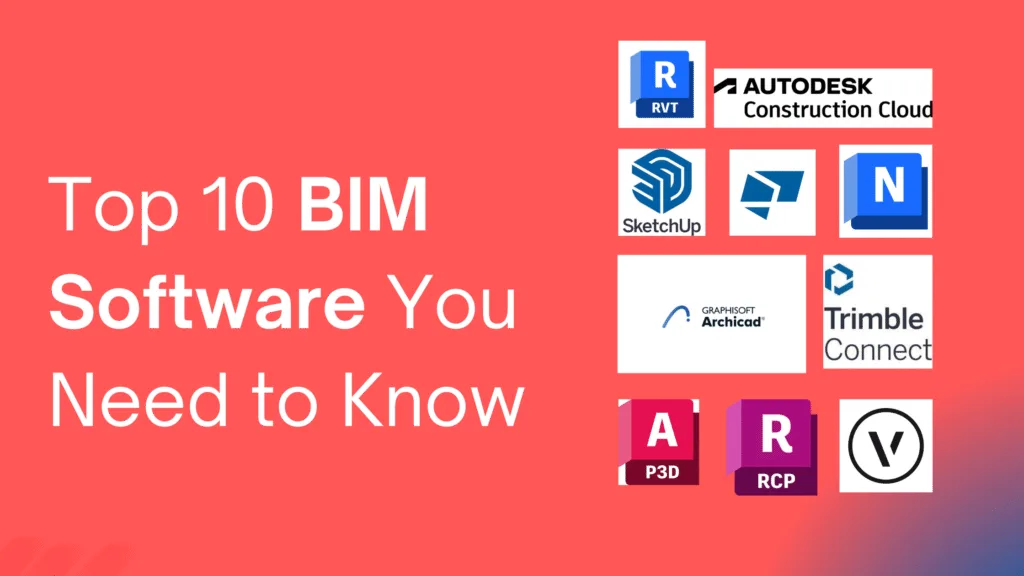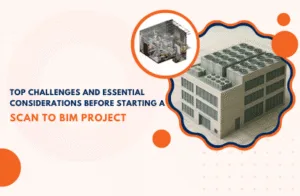Building Information Modeling (BIM) has changed how projects take shape in the architecture, engineering, and construction world. It helps teams work together better, plan smarter, and reduce costly mistakes. As technology keeps moving forward, BIM tools now offer more automation, accuracy, and real-time collaboration.

Choosing the right software can make a big difference in project quality and speed. In 2025, many new and improved BIM platforms are helping professionals design and manage projects with more control and insight.
This list highlights the top 10 BIM software you should know this year – each trusted by industry experts and built to simplify your workflow while improving results.
Let’s look at which tools stand out and why they matter today.
Autodesk Revit
Autodesk Revit is one of the most trusted BIM tools in the industry. It allows architects, engineers, and construction professionals to plan, design, and manage projects with precision. Revit focuses on collaboration and smart modeling, helping teams create accurate digital representations of physical spaces. Its parametric components let you easily place and modify elements like walls, doors, and windows while maintaining design intent. The software connects multiple disciplines in one environment, reducing rework and improving coordination.
Key Features
- Parametric Components: Design with flexibility using intelligent 3D elements that adjust automatically.
- Interoperability: Supports major BIM and CAD formats like IFC, SKP, and OBJ for seamless collaboration.
- Twinmotion Integration: Turn models into photorealistic visuals directly from Revit.
- Worksharing: Collaborate in real time through a shared central model.
- Documentation and Schedules: Create detailed drawings, sheets, and project data with ease.
Why It Stands Out
Revit stands out for its strong multidisciplinary toolset and deep integration with other Autodesk products. Its ability to connect design, visualization, and construction data in one space makes it a powerful choice. The blend of flexibility, collaboration, and real-time project control keeps Revit at the top of the BIM software list.
Navisworks
Navisworks by Autodesk is a powerful project review tool used across architecture, engineering, and construction. It helps teams combine and explore 3D models from different software in one place. The tool makes it easy to open NWD and 3D DWF files for quick review and coordination.
Key Features
- View complete model hierarchy, object properties, and embedded review data.
- Use advanced navigation tools like Walk, Orbit, Fly, and Turntable.
- Enjoy real-time display of materials and lighting for realistic visualization.
Why It Stands Out
Navisworks stands out for its smooth model integration, precise navigation, and easy collaboration during project review.
Tekla Structures
Tekla Structures by Trimble is a leading BIM software built for structural engineers, detailers, and fabricators. It allows users to create accurate 3D models of steel, concrete, and timber structures that can be used from design to fabrication. The software focuses on constructible models that support real-world building processes, helping teams avoid errors and reduce rework.
Key Features
- Create highly detailed and data-rich 3D structural models.
- Support for steel, concrete, and rebar modeling.
- Generate fabrication drawings, reports, and schedules directly from the model.
- Integrate smoothly with other BIM and analysis tools.
Enable collaboration through shared models and cloud access.
Why It Stands Out
Tekla Structures stands out for its accuracy and constructible modeling approach. It bridges the gap between design and on-site execution, giving users a clear view of every detail before construction begins.
Archicad (Graphisoft)
Archicad by Graphisoft is one of the most user-friendly BIM tools for architects and designers. It helps professionals create, visualize, and document building projects in a single, integrated environment. The software supports both 2D and 3D design, making it easy to move from concept to construction without losing detail or accuracy. Its intuitive interface and powerful modeling tools make it ideal for creative design workflows.
Key Features
- Intuitive modeling for 2D and 3D designs in one platform.
- Real-time collaboration through BIMcloud.
- Advanced visualization with integrated rendering tools.
- Seamless data exchange with openBIM support (IFC, DWG, and more).
- Automated documentation and project updates.
Why It Stands Out
Archicad stands out for its simplicity, speed, and smooth teamwork. It empowers architects to focus on design while managing project data efficiently. The combination of strong design tools and real-time collaboration makes it a favorite among creative professionals.
SketchUp
SketchUp is one of the most popular 3D modeling tools used by architects, designers, and construction professionals. Known for its simple interface and fast learning curve, it allows users to create detailed 3D models quickly and accurately. From concept design to presentation, SketchUp helps bring creative ideas to life with ease. It’s ideal for early-stage modeling, visualization, and coordination within the BIM workflow.
Key Features
- Intuitive 3D modeling with easy drag-and-drop tools.
- Vast library of pre-built models in 3D Warehouse.
- Real-time rendering and visualization plugins.
- Integration with LayOut for creating 2D drawings.
- Compatibility with major BIM and CAD formats.
Why It Stands Out
SketchUp stands out for its speed, simplicity, and flexibility. It’s perfect for visualizing ideas early in the design process while staying connected to the broader BIM ecosystem.
Autodesk Construction Cloud (ACC)
Autodesk Construction Cloud (ACC) is a unified construction management platform that connects workflows, teams, and data across the entire building lifecycle. It helps construction professionals increase efficiency, reduce risk, and improve collaboration from design through construction to operations.
Key Features
- Document Management: Centralized storage for drawings, models, and documents with version control and real-time access.
- Project Management: Track RFIs, submittals, tasks, and issues across multiple projects.
- Cost Management: Budget tracking, change order management, and cost forecasting.
- Field Collaboration: Mobile access for field teams to capture data, conduct inspections, and update project status in real time.
Why It Stands Out
Autodesk Construction Cloud stands out because it unifies design, project, and field workflows in a single platform, enabling real-time collaboration, reducing errors, and improving efficiency. Its seamless integration with Autodesk tools and cloud-based accessibility ensures teams can work smarter, stay connected, and deliver projects on time and within budget.
Trimble Connect
Trimble Connect is a cloud-based collaboration platform that enables construction, engineering, and design teams to share, review, and manage project data in real time. It helps stakeholders stay connected, coordinate effectively, and make informed decisions throughout the project lifecycle.
Key Features
- 3D Model Collaboration: View, share, and annotate 3D models in real time.
- Document Management: Centralized storage for drawings, documents, and models with version control.
- Task & Issue Management: Assign tasks, track issues, and manage workflows efficiently.
- Field Access: Mobile and web access for field teams to update and review project data.
- BIM Integration: Supports multiple file formats and integrates with BIM tools for seamless coordination.
- Clash Detection & Coordination: Identify conflicts early and coordinate designs across disciplines.
- Data Analytics & Reporting: Insights on project progress, task completion, and collaboration effectiveness.
Why It Stands Out
Trimble Connect is a cloud-based collaboration platform that enables construction, engineering, and design teams to share, review, and manage project data in real time. It helps stakeholders stay connected, coordinate effectively, and make informed decisions throughout the project lifecycle.
AutoCAD Plant 3D
AutoCAD Plant 3D is a specialized design software for creating, modeling, and documenting process plants. It helps engineers design piping, equipment, and instrumentation efficiently while maintaining compliance with industry standards.
Key Features
- Piping Design: Create 3D piping models with intelligent components and specifications.
- Equipment Modeling: Design and place equipment accurately within the plant layout.
- Isometric & Orthographic Drawings: Automatically generate detailed drawings for fabrication and construction.
- Data Management: Centralized project database for components, specs, and materials.
- BOM & Reports: Generate bills of materials, reports, and schedules directly from the model.
Why It Stands Out
AutoCAD Plant 3D stands out because it streamlines plant design with intelligent modeling, automated drawing generation, and industry-standard compliance. Its integration with Autodesk tools and collaborative workflows ensures faster, more accurate design and documentation.
Autodesk ReCap
Autodesk ReCap is a reality capture software that allows users to convert laser scans and photos into accurate 3D models or 2D drawings. It is widely used in construction, architecture, and engineering to create precise digital representations of physical environments.
Key Features
- Laser Scan Processing: Import, clean, and process point cloud data from 3D laser scans.
- Photogrammetry: Convert photographs into 3D models for design and analysis.
- Point Cloud Editing: Tools to segment, classify, and optimize point cloud data.
- Measurement & Analysis: Accurate measurements directly within the 3D model.
- Integration with Autodesk Tools: Seamless export to Revit, AutoCAD, Civil 3D, and other design software.
- Collaboration: Share models with teams in the cloud for review and coordination.
- Visualization: View and navigate large point clouds with high performance.
Why It Stands Out
Autodesk ReCap stands out by transforming real-world data into precise 3D models, enabling accurate planning, design, and analysis. Its integration with Autodesk’s ecosystem and ability to handle large point clouds make it indispensable for survey, construction, and renovation projects.
Vectorworks Architect
Vectorworks Architect is a comprehensive BIM and CAD software tailored for architects and designers. It allows users to create 2D drawings, 3D models, and fully coordinated building information models, supporting the entire design and documentation process.
Key Features
- 2D Drafting & Drawing: Powerful tools for precise architectural drawings.
- 3D Modeling: Create complex forms, surfaces, and parametric structures.
- BIM Capabilities: Full building information modeling with intelligent objects.
- Rendering & Visualization: High-quality renderings and presentations directly in the software.
- Collaboration Tools: Share models with consultants and integrate with other BIM tools.
- Documentation & Annotation: Automated schedules, reports, and annotations from the model.
- Energy & Performance Analysis: Tools for early-stage energy modeling and design evaluation.
Why It Stands Out
Vectorworks Architect stands out because it combines robust 2D drafting, 3D modeling, and BIM in a single platform, giving architects the flexibility to design creatively while maintaining precise documentation. Its strong visualization and collaboration features make it ideal for end-to-end architectural workflows.
What to consider when choosing a BIM software
When choosing the right BIM software for your projects, there are several critical factors to keep in mind. As someone deeply involved in the BIM industry, I often see teams overlook these points, but paying attention to them can save you time, money, and headaches. Here’s what you should consider:
Project Requirements First: Always start by understanding the scope and complexity of your projects. Are you working on large infrastructure projects, small buildings, or specialized MEP systems? The software should align with your project type.
Ease of Use & Learning Curve: A powerful tool is only effective if your team can use it efficiently. Consider software with an intuitive interface and strong training resources.
Interoperability: BIM projects often involve multiple stakeholders using different tools. Make sure the software supports common file formats (like IFC, DWG, RVT) and integrates smoothly with other platforms.
Collaboration & Cloud Capabilities: Modern BIM relies on real-time collaboration. Look for tools that allow multiple team members to work simultaneously, with cloud access for field and office teams.
Customization & Flexibility: Each project and firm has unique workflows. The software should allow customization of templates, families, and workflows to fit your processes.
Visualization & Documentation: Check if the software provides high-quality visualization, 3D modeling, and automated documentation features. This helps in better client presentations and reduces manual errors.
Cost vs. Value: Evaluate the licensing costs against the features and long-term benefits. Sometimes a higher upfront cost pays off in improved efficiency and fewer errors.
Support & Community: Strong technical support, user forums, and a robust community can make a big difference, especially when troubleshooting complex project issues.Future Scalability: Consider your firm’s growth and upcoming project types. The software should scale with your team’s needs and emerging BIM technologies.
Conclusion
Choosing the right BIM software is a critical decision that directly impacts project efficiency, collaboration, and overall success. As a BIM industry expert, I can confidently say that selecting a tool should go beyond features and cost. It’s about understanding your project requirements, ensuring seamless collaboration, supporting interoperability, and enabling future scalability.
The right software empowers teams to produce accurate models, high-quality documentation, and insightful visualizations while minimizing errors and rework. When you carefully evaluate options based on usability, integration, support, and long-term value, you set your projects up for success.
Ultimately, the ability to streamline workflows, improve communication, and deliver projects on time and within budget hinges on this choice. For organizations seeking a trusted partner in navigating these decisions, knowing how to choose the right BIM services provider ensures that both the software and implementation strategy align perfectly.






